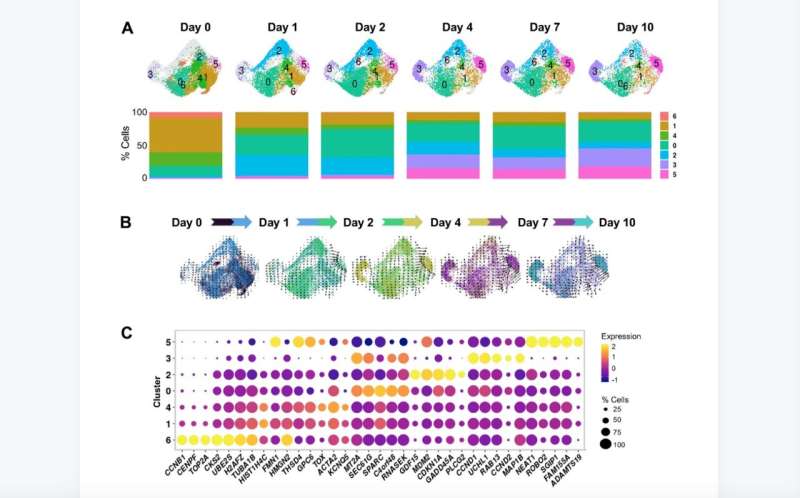This article has been reviewed according to Science X's editorial process and policies. Editors have highlighted the following attributes while ensuring the content's credibility:
fact-checked
proofread
Single-cell transcriptomic analysis uncovers diverse and dynamic senescent cell populations

A new research paper titled "Single-cell transcriptomic analysis uncovers diverse and dynamic senescent cell populations" has been published in Aging.
Senescence is a state of enduring growth arrest triggered by sublethal cell damage. Given that senescent cells actively secrete proinflammatory and matrix-remodeling proteins, their accumulation in tissues of older persons has been linked to many diseases of aging. Despite intense interest in identifying robust markers of senescence, the highly heterogeneous and dynamic nature of the senescent phenotype has made this task difficult.
In this new study, researchers Noah Wechter, Martina Rossi, Carlos Anerillas, Dimitrios Tsitsipatis, Yulan Piao, Jinshui Fan, Jennifer L. Martindale, Supriyo De, Krystyna Mazan-Mamczarz, and Myriam Gorospe from the National Institute on Aging set out to comprehensively analyze the senescent transcriptome of human diploid fibroblasts at the individual-cell scale by performing single-cell RNA-sequencing analysis through two approaches.
"Here, we used single-cell RNA sequencing (scRNA-seq) analysis to document both the diverse transcriptomes of human senescent fibroblasts at an individual-cell scale, and the changes in the transcriptome over time during etoposide-triggered senescence," the authors explain.
First, the researchers characterized the different cell states in cultures undergoing senescence triggered by different stresses, and found distinct cell subpopulations that expressed mRNAs encoding proteins with roles in growth arrest, survival and the secretory phenotype. Second, they characterized the dynamic changes in the transcriptomes of cells as they developed etoposide-induced senescence.
By tracking cell transitions across this process, the researchers found two different senescence programs that developed divergently, one in which cells expressed traditional senescence markers such as p16 (CDKN2A) mRNA, and another in which cells expressed long noncoding RNAs and splicing was dysregulated. Finally, they obtained evidence that the proliferation status at the time of senescence initiation affected the path of senescence, as determined based on the expressed RNAs.
The researchers conclude, "We propose that a deeper understanding of the transcriptomes during the progression of different senescent cell phenotypes will help develop more effective interventions directed at this detrimental cell population."
More information: Noah Wechter et al, Single-cell transcriptomic analysis uncovers diverse and dynamic senescent cell populations, Aging (2023). DOI: 10.18632/aging.204666




















